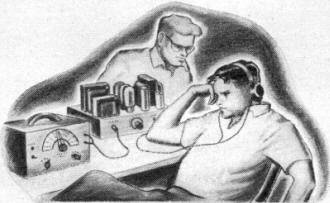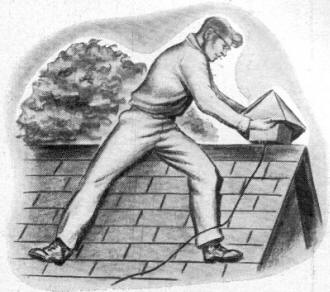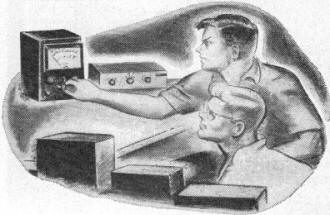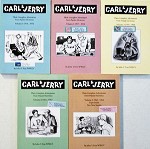Carl & Jerry: A Hot Idea
|
|||||||
That John T. Frye was a great short story writer is evidenced by his decades-long production of the "Carl & Jerry" series in Popular Electronics, and "Mac's Radio Service Shop" series in Radio & Television News and Electronics-World magazines. Mr. Frye also wrote many other short tech-oriented stories. It is easy to look over the fact that he also had artistic skills as well as evidenced by the pencil drawings that accompanied each installment. In this episode, our two teenaged electronics hobbyists build a resistor anemometer to measure wind speed from within their basement workshop. In the usually storyline style, one boy gives a lesson in circuit design while the other (also the reader) is the attentive student. Carl & Jerry: A Hot Idea  By John T Frye By John T Frye
W9EGV The buffeting March wind spanked Carl with the slamming basement door as he stepped into the electronic laboratory of his friend, Jerry: The latter was sitting with his head encased in a pair of muff-type earphones connected to an amplifier with a variable frequency audio oscillator working into its input. As Carl looked at his chum aimlessly adjusting the frequency of the oscillator and the gain of the amplifier, he decided there was something about Jerry's appearance that was not right. There was a certain lackluster look about his eyes, and his round face looked fatter than ever - but in a sort of lopsided way. "Guess I'm the one guy in ten for whom it won't work," Jerry said with a lugubrious sigh as he shut off the equipment and removed the earphones. "What won't work, and what's the matter with your face? It looks twice as big as it ought to." "The 'audio anesthetic' won't work for me. I've got an infected wisdom tooth that's killing me, and I have an appointment with the dentist in an hour. But the other day I read that a Boston dentist discovered that music or random noise put into earphones worn by a patient killed the pain of dental work in 90% of 2000 cases tested. The patient adjusts the sound level with a gain control in his lap until the sound blocks out the pain sensation. A company in Rochester is already in production on the device. I was trying to see if I could kill the pain of my toothache with various frequencies from the audio generator, but I couldn't." "That thing must work on a variation of the 'mule skinner' principle," Carl said. "You know a veteran mule skinner always took the ear of a mean mule between his teeth and bit down hard while he was putting on the bridle. The idea was that while the mule was thinking about how much his ear hurt he couldn't think about kicking or biting the mule skinner. With the audio anesthetic, while the mind is concentrating on the sound it ignores the pain. Your trouble is that in fooling around with ham radio, etc., you've trained yourself to be a little smarter than the mule. You can listen and still be thinking about your aching tooth at the same time. Well, I better scram and let you go to the dentist." "Oh, no, you don't!" Jerry exclaimed. "I've a little chore for you to perform while I'm gone; and I just know you wouldn't refuse your poor, pain-wracked buddy." "Depends on what my poor, pain-wracked, scheming buddy has in mind." "All I want you to do is mount this thermistor anemometer out on the garage and run this cable from it back into the lab." "You know," Carl said thoughtfully, "I don't think you've got a toothache at all. You've just dislocated your jaw on one of those big words you're so fond of. What the heck is a 'Mistermometer'?" "I said a 'thermistor anemometer.' As you know, or should know, an anemometer is a device for, measuring wind velocity. This one is intended to do so by the use of thermistors. A 'thermistor' is a resistor whose resistance changes, in a nonlinear fashion, incidentally, with a change in temperature. The temperature affecting the resistance may arise externally or it may come from current flowing through the thermistor. In the case of these thermistors you see on the bench, an increase from -60 to plus 150 degrees centigrade will cause the resistance to fall from about 2000 ohms to one ohm." "That sounds dandy for measuring temperature, but I don't see how they can be used to measure wind velocity." "Keep listening and you will." "I've arranged two matched thermistors and two resistors - one variable - in a bridge circuit," Jerry explained as he sketched the familiar diamond-shaped bridge circuit. "These two top legs are the thermistors; the two bottom legs are the resistors. Here's a battery in series with a switch connected between the common junction of the two thermistors up here and the common junction of the two resistors at the bottom. A d.c. meter connects from this left-hand thermistor-resistor junction across to the right-hand thermistor-resistor junction. "Now, when the variable resistor is properly adjusted to equal the fixed resistor, the battery current divides equally between the left and right sides of the bridge. Since the same current flows through each thermistor, any resistance change in one is duplicated by the resistance change in the other, and the bridge stays in balance. Voltage drop along the two sides is identical, and no current flows through the meter." "How do you know the thermistors in your bridge are matched?" "Because I matched 'em. I put the bridge in the freezer where the temperature is below zero and then put it in that light-bulb-heated oven and brought the temperature up to 150 degrees. I kept repeating this test with different combinations of thermistors until I found two that would go through the temperature swing with practically no indication of current through the meter at any point. You satisfied?" "Yep, but how does the thing measure wind velocity?" "As you can see, one thermistor is mounted inside this aluminum can with tiny holes in the top and bottom to permit outside air to filter very slowly through. The other thermistor is mounted out in the open so wind can blow around it freely. When battery current flows through both thermistors, heating them, the heat is lost to the surrounding air. In a dead calm, the heat lost by the enclosed thermistor and the heat lost by the one outside in absolutely still air will be the same and no reading will show on the meter. "However, when a wind is blowing, the heat from the exposed thermistor will be carried away; the harder the wind blows, the faster heat is lost. Heat lost by the enclosed thermistor in its artificial calm will remain the same. The wind-cooled thermistor will stay high in resistance while its hotter buddy inside the can will go lower in resistance,. unbalancing the bridge and permitting current to flow through the meter. All we have to do is to calibrate this current-indicating meter in terms of wind miles per hour and we have a remote-indicating anemometer with no moving parts." "I suppose. this little wooden umbrella-shaped canopy is to keep the sun and rain from influencing the reading." "Right. Actually the whole thing is pretty crude, but I want to put it up for a while and see how much rain and sun does affect it. This variable March weather is ideal for making such a study. Will you put it up?" "Oh, I reckon," Carl said gruffly. "Quit stalling and get to the doctor." Actually Carl was as eager as his friend to tryout the new gadget, and he lost no time after Jerry had gone. It took but a few moments to fasten the device securely to the garage gable and to run the four-wire TV antenna rotor cable back into the basement through a casement window. There he connected two of the wires to the battery-and-switch combination, and the other two were connected to the milliammeter. When the switch was thrown, the meter indicated up-scale; and Carl was fascinated by the way the meter reading kept step with the roar of the March wind outside. He was still watching the meter when Jerry came in the door. "You're still kind of fat in the face," Carl remarked critically, "but you look better. Could he save the tooth?" "He can if he wants to; I left it with him," Jerry replied breezily. "He yanked it out, and it didn't hurt a bit." "Just wait until that dope starts dying out," Carl said with the voice of experience. "Your gadget is working fine, Jer. Watch how the meter pointer moves up every time the wind bends the tops of those trees through the window there - hey, that's funny," he broke off. "It was working swell, but look at the crazy way it's behaving now." The meter was acting strangely. No longer did the pointer keep step with the roar of the wind. First it bobbed up and down the scale erratically and then began backing off scale below zero. Finally it settled firmly against the left-hand stop and refused to budge until Carl opened the switch; then it came to rest on zero. "Something's gone wrong out there. You stay here and watch the meter while I go have a look," Carl suggested. He had hardly reached the top of the outside basement stairs when he began shouting; "Call the fire department! Call the fire department! Kreuger's barn across the alley is on fire, and is it ever going!" Jerry rushed upstairs and called the fire department, and then he ran out in the back yard. By this time the old two-story frame barn across the alley was a mass of flames; and blazing shingles were sailing all around. Long tongues of flame reached across and licked at Jerry's garage. The fire department came roaring up and started playing water on the burning barn and the other buildings nearby, but the fire was not put under control until it had burned the high tension wires overhead in two. "Boys, that was close," the fire chief said to Carl and Jerry. "If the thing had had ten minutes more start with this wind, that whole row of garages could easily have gone. It certainly is a good thing you spotted it when you did. How did you happen to see it?" "Well, we were kind of tipped off by a sort of fire detector we had installed on our garage roof," Jerry explained lamely. He knew from bitter experience the difficulty of trying to describe the working of electronic equipment to people without an electronic background. "Actually it's not hard to figure what happened," he said to Carl after the chief had gone and the two boys were walking back to their laboratory. "The wind was blowing right from the fire toward our garage. When a tongue of flame would lick over and slu-u-urp that exposed thermistor, the can would protect the enclosed thermistor from the quick increase in temperature. As a result, the exposed thermistor got hotter than the enclosed one, and this made the meter read backward." Jer, old buddy," Carl said as he laid an affectionate arm across his friend's shoulders, "the thing I like about you as an inventor is that you always invent something. Of course, you may set out to invent a thermistor anemometer and end up with a jim-dandy fire detector; but, by golly, you come up with something! Man, you're the most!" "Thanks, pal - I think!" Jerry answered as he grinned crookedly up with his still swollen face at his friend.
Posted June 15, 2021 |
|||||||





 Carl & Jerry, by John T. Frye
Carl & Jerry, by John T. Frye